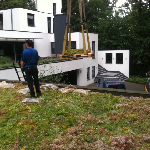
Greening the roofs with real plants by Instagreen
Pitch
Roofs can be planted with special plants. Multiple advantages: less urban heat island, better insulation, water retention and a nicer view.
Description
Summary
Roofs can be used for multiple purposes. By adding plants to roofs there are multiple advantages:
- Less urban heat island: The plants are both absorbing the heat, evaporating water and have a lower albedo then the roofing membrane. So extra cooling is created.
- Better insulation for the building below; Both during summer and the winter. In the summer due to the extra layer, the plants and the evaporating water of these plants. In the winter due to the extra layer.
- Longer life time of the roofing membranes: As the extreme temperatures are reduced and the membranes are protected from the light, they last longer.
- Biodiversity; by the selection of the proper plants insects are attracted and fed. These insects are then attracting birds.
- View: the "boring" roof is transferred into a lively garden.
Usually are the disadvantages:
- the extra weight to the roof
- the installation time
- the time before the plants are fully grown.
But by using a pre-grown plants in a substrate we overcome these disadvantages.
The plants are pre-grown in a horticultural nursery in a special substrate. The nursery takes care for the proper selection of the plants and during the fragile growing stages of the plants.
The plant medium is a special substrate, this buffers sufficient water for the dry periods, but is light enough that existing roofs can carry this extra load.
The installation is very easy as the pre-grown substrate plates can be handled by one person and the plants are fully grown and strong enough. The weight of each element is about 3 kilogram and their dimension 1 foot by 2 foot. The installation doesn't require special equipment or maintenance. Only after the installation the plants needs to be watered once. Once a year the plants needs to be inspected (but this is also required for a conventional roof).
And above all the roof looks very nice and is green in all aspects.
Category of the action
Adaptation
Who will take these actions?
Building owners: Facilitate by using the roofs.
Government: Preferably a small subsidy to cover the extra costs for the building owner. As the advantages are partially for the "commons".
Water board: Less rain water in the sewer system, so less costs of treating the water.
Business - Local plant nurseries: Supplying the plants.
Business - Regional: Supply the special light weight substrate material.
Individuals: Less heat during the summer and a nicer view of the green roofs.
What are other key benefits?
Lower temperatures in the building below: As the extra plants (and the used substrate) acts as an extra insulation, there is less heat transferred. Both during the summer (less heating) and during the winter (less cooling).
Water retention: About halve of the yearly rainfall is used by the plants. The other halve is buffered, so the water outflow is more balanced. This lowers the loading of both the sewer system and the water treatment and thereby saves costs.
Noise: the noise is both lowered in the building (the extra layer) and outside (absorption).
What are the proposal’s costs?
The costs are about € 50 per square meter (sorry I am Dutch and therefor using the SI-units ;-) ). For the building owner are the financial advantages the longer life time of the roofing membranes and the better insulation. But the other advantages are for "the commons".
Time line
Very short term: With local plant nurseries establish the required variety of plants (mainly sedum plants).
Short term: Installation and gaining experience.
Medium term: Standard for all the roofs. The effects are noticeable, both the lowered heat island effect, the water retention.
Long term: Standard at all buildings. Reduced urban heat island effect, less water to the drainage system. And a higher bio-diversity.
Related proposals
References
In Europe (especially in Germany) there is intense experience with green roofs. In quite some villages this is the standard practice.
The main disadvantage are the costs, the installation time, the time it takes before the roof is fully grown and the required knowledge. From the conventional systems there is plenty experience and refernce material. See i.e.
http://en.wikipedia.org/wiki/Green_roof
http://www.greenroofs.org/index.php/about/greenroofbenefits
But the proposed system is new and innovative